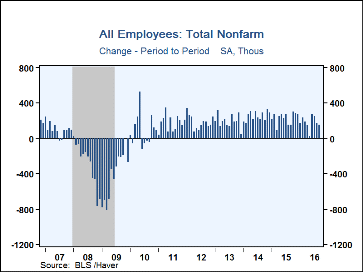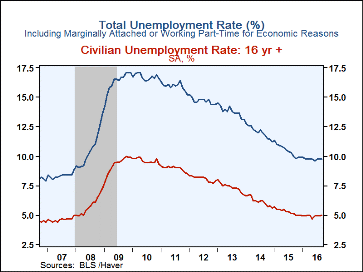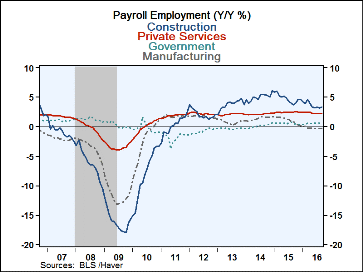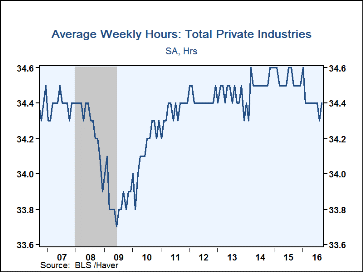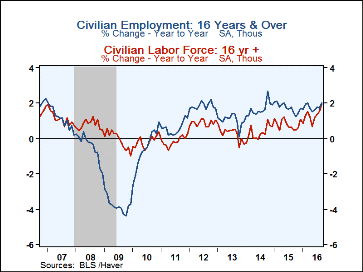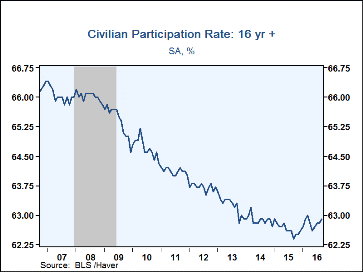 Global| Oct 07 2016
Global| Oct 07 2016U.S. Payroll Increase Eases; Unemployment Rate Ticks Higher
by:Tom Moeller
|in:Economy in Brief
Summary
The job market is settling onto a path of moderate improvement. Nonfarm payroll employment increased 156,000 (1.7% y/y) during September following revised gains of 167,000 and 252,000 during the prior two months. These where reported [...]
The job market is settling onto a path of moderate improvement. Nonfarm payroll employment increased 156,000 (1.7% y/y) during September following revised gains of 167,000 and 252,000 during the prior two months. These where reported as 151,000 and 275,000 last month. A 168,000 rise in employment had been expected in the Action Economics Forecast Survey. Growth in payrolls was limited to the construction and private service sectors last month. From the household survey, the unemployment rate ticked up to 5.0%, its highest level since April. A 4.9% rate had been expected. The overall unemployment rate, including marginally attached and those working part-time for economic reasons held steady at 9.7%. Average hourly earnings rose an expected 0.2% (2.6% y/y).
From the payroll employment survey, the 156,000 increase reflected a 23,000 gain (3.4% y/y) in construction sector jobs, which followed declines in four of the prior five months. Factory sector employment declined 13,000 (-0.4% y/y) after a 16,000 fall. Mining sector jobs ticked 2,000 higher (-14.5% y/y), but remained off 25.8% from the peak two years ago.
Employment in the private service sector increased 157,000 (2.2% y/y), the smallest increase since May. Professional & business services jobs rose 67,000 (2.9% y/y) after a 31,000 gain, as temporary help jobs grew 23,200 (1.9% y/y) following a 1,000 decline. Health care employment increased 32,700 (2.9% y/y) after a 22,300 rise. Employment in the retail sector improved 22,000 (2.0% y/y), about the same as in August. Leisure & hospitality hiring improved 15,000 (2.4% y/y), the smallest gain since May. Jobs in education rose 7,000 (2.1% y/y). Financial activity employment rose 6,000 (2.0% y/y), the smallest rise since February, and information sector hiring improved 1,000 (0.3% y/y).
Government sector employment declined 11,000 (+0.7% y/y), the first drop since April. The decline was paced by the local government sector where jobs fell 15,000 (+0.8% y/y), the first decline since November. State government jobs remained unchanged (-0.1% y/y), while federal government hiring improved 4,000 (1.5% y/y) after a 2,000 rise.
The length of the average workweek rose to 34.4 hours, about where it's been all year. The mining sector workweek rose m/m to 43.4 hours, but that was down from the high of 45.7 hours in March of 2014. The factory sector workweek lengthened to 40.7 hours, and hours in construction rose to 39.1 hours. Private sector hours rose to 33.3 as financial sector hours rose to 37.5 and professional & business services hours ticked up to 36.1. Education & health services hours were unchanged at 32.9 while leisure & hospitality hours were 26.1. The index of aggregate hours worked (employment times hours) rose 1.3% (AR) last quarter after a 0.8% Q2 rise.
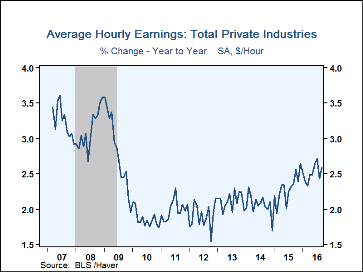 Average hourly earnings grew 0.2% last month (2.6% y/y) after
a 0.1% gain. The increase was paced by a 0.5% rise (1.8% y/y) in mining &
logging. Construction sector earnings grew 0.3% (3.4% y/y) while factory sector
pay improved 0.3% (3.0% y/y). Private service sector earnings rose 0.2% (2.6%
y/y), held back by a 0.1% uptick (2.5% y/y) in financial activities pay.
Professional & business services earnings were unchanged (2.2% y/y). These
weak gains were accompanied by a 0.6% increase (4.8% y/y) in the leisure &
hospitality sector and a 0.3% rise (1.8% y/y) in education & health services.
Average hourly earnings grew 0.2% last month (2.6% y/y) after
a 0.1% gain. The increase was paced by a 0.5% rise (1.8% y/y) in mining &
logging. Construction sector earnings grew 0.3% (3.4% y/y) while factory sector
pay improved 0.3% (3.0% y/y). Private service sector earnings rose 0.2% (2.6%
y/y), held back by a 0.1% uptick (2.5% y/y) in financial activities pay.
Professional & business services earnings were unchanged (2.2% y/y). These
weak gains were accompanied by a 0.6% increase (4.8% y/y) in the leisure &
hospitality sector and a 0.3% rise (1.8% y/y) in education & health services.
From the household employment survey, the rise in the unemployment rate to 5.0% reflected a 354,000 gain (2.0% y/y) in employment and a 444,000 jump (1.9% y/y) in the labor force. The labor force participation rate increased to 62.9%, the highest level in six months, up from the September low of 62.4. The size of the population grew 1.1% to 254.1 million. The average duration of unemployment eased to 27.5 weeks, down from the high of 39.4 weeks averaged in 2012 and 2011.
The teenage unemployment rate inched up to 15.9%, while for those who were 20-24 its was steady at 8.1%. The unemployment rate for those over age 25 rose to 4.2%. For 45-54 year olds, unemployment was 3.6%, and for 35 to 44 year olds, it was 4.1%. Unemployment amongst workers aged 25-34 was 5.2%.
By education, unemployment amongst those without a high school diploma jumped to 8.5%, the highest level since May of last year. High school graduates with no college realized 5.2% unemployment. For those with some college, but less than a bachelors degree it was 4.2%. College graduates realized 2.5% unemployment.
The labor market data are contained in Haver's USECON database. Detailed figures are in the EMPL and LABOR databases. The expectations figure is in the AS1REPNA database.
| Employment: (SA, M/M Change, 000s) | Sep | Aug | Jul | Sep Y/Y | 2015 | 2014 | 2013 |
|---|---|---|---|---|---|---|---|
| Payroll Employment | 156 | 167 | 252 | 1.7 | 2.1% | 1.9% | 1.6% |
| Previous | -- | 151 | 275 | -- | -- | -- | -- |
| Manufacturing | -13 | -16 | 2 | -0.4 | 1.1 | 1.4 | 0.8 |
| Construction | 23 | -5 | 16 | 3.4 | 4.8 | 5.0 | 3.7 |
| Private Service-Producing | 157 | 169 | 207 | 2.2 | 2.5 | 2.1 | 2.1 |
| Government | -11 | 23 | 31 | 0.7 | 0.5 | 0.0 | -0.3 |
| Average Weekly Hours - Private Sector | 34.4 | 34.3 | 34.4 | 34.5 | 34.5 | 34.5 | 34.5 |
| Private Sector Average Hourly Earnings (%) | 0.2 | 0.1 | 0.4 | 2.6 | 2.3 | 2.1 | 2.1 |
| Unemployment Rate (%) | 5.0 | 4.9 | 4.9 | 5.1 | 5.3 | 6.2 | 7.4 |
Tom Moeller
AuthorMore in Author Profile »Prior to joining Haver Analytics in 2000, Mr. Moeller worked as the Economist at Chancellor Capital Management from 1985 to 1999. There, he developed comprehensive economic forecasts and interpreted economic data for equity and fixed income portfolio managers. Also at Chancellor, Mr. Moeller worked as an equity analyst and was responsible for researching and rating companies in the economically sensitive automobile and housing industries for investment in Chancellor’s equity portfolio. Prior to joining Chancellor, Mr. Moeller was an Economist at Citibank from 1979 to 1984. He also analyzed pricing behavior in the metals industry for the Council on Wage and Price Stability in Washington, D.C. In 1999, Mr. Moeller received the award for most accurate forecast from the Forecasters' Club of New York. From 1990 to 1992 he was President of the New York Association for Business Economists. Mr. Moeller earned an M.B.A. in Finance from Fordham University, where he graduated in 1987. He holds a Bachelor of Arts in Economics from George Washington University.


